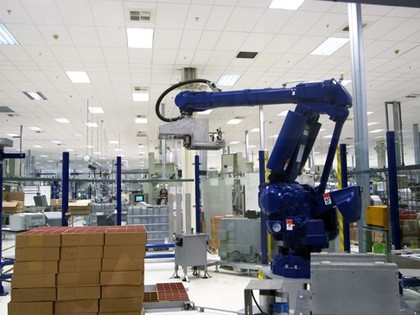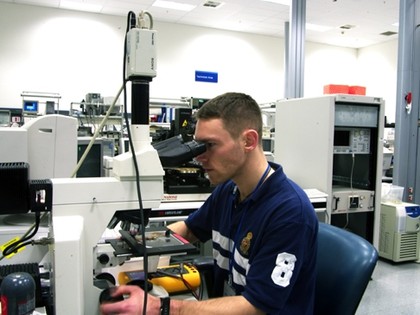How an inkjet nozzle fires 36,000 times a second
Filling and testing
Then we move on to the filling process. This is the "Wet Loop." What about the toxicity of inks, we ask – is it possible to have non-toxic inks? "We use the lowest amount of toxicity versus effectiveness" says our guide.
Four cartridges are filled at any one time, taking four to five seconds to fill each of them in a vacuum.
A high pressure is used to fill the cartridges from 1,000 litre tanks which are rolled around the facility. A huge ink splodge on the ceiling is the result of a time when the pressure got a little too much.
After the cartridges are filled, the nozzles are fired to test them. A vent in the top of the cartridge enables air to replace the ink as it's used, though access is via a labyrinth channel to prevent ink evaporation.
After a test print, the nozzles are sealed by the tape that you remove when you install them in your printer.
Finally, the cartridges are sealed and loaded into boxes and sent elsewhere to be placed in their sale packaging.

The electrical process is tested out at several stages throughout the process and techniques such as X-rays are used to see inside the cartridge as it prints in a special test area filled with tens of printers and old machines. An autopsy area seeks out the causes of problem cartridges. Long-life testing also takes place here.

"The physics of what happens inside a printer is quite extraordinary," says HP's Pat Harnett. "There's mathematics, temperature, process and fluid dynamics. It takes a lot of tuning to get it right on different papers."
Sign up for breaking news, reviews, opinion, top tech deals, and more.
"It's not as simple as millilitres of ink – there's a lot more behind that in terms of the nozzle balance. And it's not just about millilitres, it's about pages."

But how much of the cartridge uses recycled material? According to Harnett, it was 70 per cent in 2008. "You want an HP cartridge that's made of a recycled material but with all the benefit of buying an original HP cartridge. There's a mixture of both using content and complete recycling," he explains.
"Virgin material is much easier from a technologist's point a view. In recycled content there's the possibility of interaction with the ink. We need to get the wall thicknesses correct for example. A lot of research has to go into it. The difference between 70 per cent and 80 per cent [is] a lot of effort."
Dan (Twitter, Google+) is TechRadar's Former Deputy Editor and is now in charge at our sister site T3.com. Covering all things computing, internet and mobile he's a seasoned regular at major tech shows such as CES, IFA and Mobile World Congress. Dan has also been a tech expert for many outlets including BBC Radio 4, 5Live and the World Service, The Sun and ITV News.